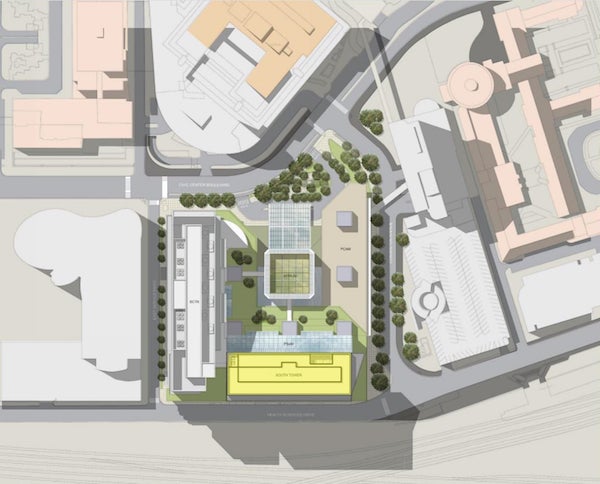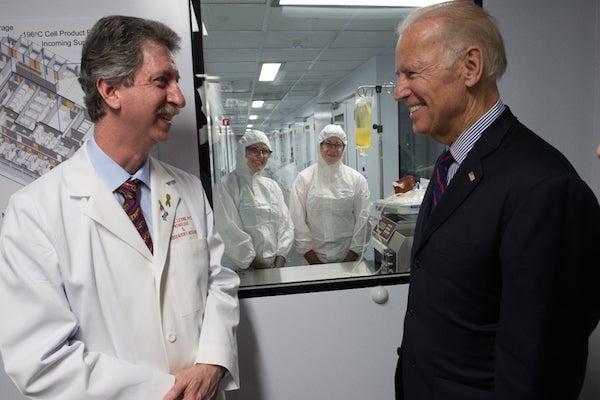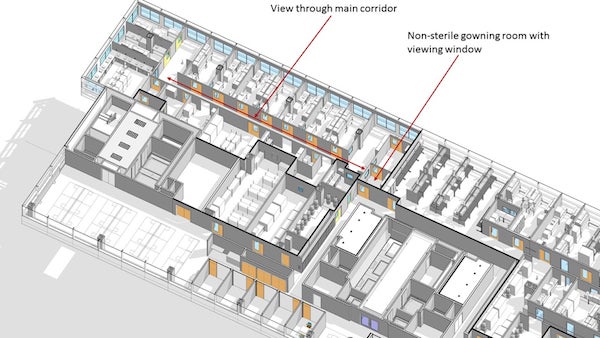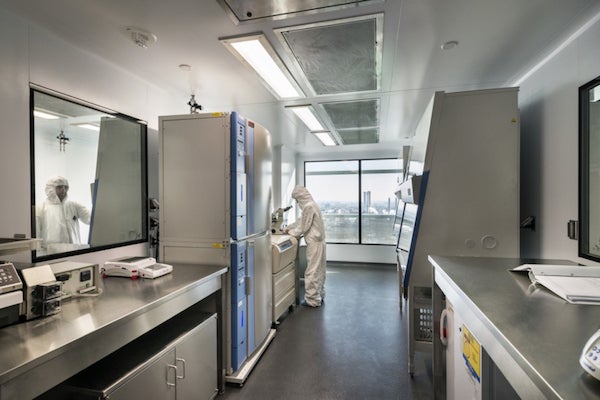This article was published in Scientific American’s former blog network and reflects the views of the author, not necessarily those of Scientific American
One of the most promising recent trends in cancer research is the development of groundbreaking immunotherapies that use patients’ own immune systems to fight their illness. Our institution is among the leaders in this exciting new area of investigation, and we realized early on that the way laboratories are laid out can make a significant difference to how efficiently new therapies can be developed and tested.
So, as we envisioned and planned the Novartis-Penn Center for Advanced Cellular Therapies (CACT), we wanted a design that promoted close interaction and integration of the CACT within the larger cellular immunotherapy research program. Our goal was to create a critical mass of discovery and production research that would optimize work environments for scientists; maximize process efficiency; allow for flexibility; fuel innovation; and help to attract and retain top talent.
Based on our experience, we have identified six ways that strategically designed research facilities are helping accelerate our fight against cancer.
On supporting science journalism
If you're enjoying this article, consider supporting our award-winning journalism by subscribing. By purchasing a subscription you are helping to ensure the future of impactful stories about the discoveries and ideas shaping our world today.
1. Optimizing Geographic Proximity
When solving for a challenge as complex and multidisciplinary as developing new immunotherapies, there is a high correlation between proximity and productivity. So, we created an environment where it takes no more than a minute for our scientists and technicians to walk from the manufacturing facility to the research labs and everything in between. This ensures that specialty teams, including those focused on manufacturing, quality, clinical operations and facilities operations, can always gather quickly, problem-solve and troubleshoot face-to-face.
Just as important as the proximity of teams is the proximity of the larger surrounding health care, education and research environments. Within the same two connected towers as the larger cancer immunotherapy program at Penn Medicine, there are patient clinics, a medical school, animal research facilities and laboratories. This puts patients, families, staff, clinicians, scientists and students all together in a single complex. The center’s location within the 12 schools of the University at Pennsylvania even further enhances possibilities for cross-disciplinary collaboration, not only at Penn Medicine but also at the School of Veterinary Medicine and the Wharton School of business.

The CACT (located in the South Tower, highlighted) is completely interconnected to the larger immunotherapy program at Penn Medicine and the greater university campus. Credit: CannonDesign
2. Providing a Window into the Research Within
All too often, given the ultraclean environments needed for immunotherapy development, these spaces and the researchers working within them are invisible to others. This presents two challenges. The first is that operations and facilities teams can’t see issues that arise within the clean room. The second is that this incredible research is walled off from public and patient view, which means a huge missed opportunity for education and promotion. By simply working with designers to find safe and reasonable ways to put this science on display, researchers can enhance public perception; strengthen alliances with academic, professional and industrial organizations; and better facilitate dialogue with lawmakers and patient advocates.

Dr. Bruce Levine meeting with Vice President Joe Biden in front of the cleanroom viewing window. Credit: Penn Medicine
For the CACT, the solution was a three-foot by three-foot window in the non-sterile change room so that visitors, including everyone from school groups to National Geographic reporters to former Vice President Joe Biden, have been able see into the clean-room spaces without having to gown up. It is not unusual for us to welcome multiple tour groups each week, which speaks to how this facility has become a center for public awareness for how researchers are making immunotherapies a reality.

The viewing window provides a one-of-a-kind glimpse into the cleanroom’s main corridor. Credit: CannonDesign
3. Remembering the “Why”
Why put in those extra hours this week? Why invest so much time and education to get here? Why dedicate an entire working lifetime moving toward solving one of the most complex challenges humanity faces today? For many in this profession, their ultimate answer is the patients themselves. Amid the everyday pressures and stresses of the workplace, even such a noble “why” can get lost, morale can dip, and productivity can suffer.
The CACT puts the focus back on the patients in the form of simple portraits mounted on the wall. These pictures feature people whose cancers recurred, but who are now fully in remission after successful immunotherapy, and some are of patients who ultimately succumbed to their cancer. The portraits are strong reminders for everyone at the center that they are always working to improve the lives of real people. They are so impactful, in fact, that researchers will often recognize patients through the viewing window when they stop by for a tour. Last year, a former patient currently in remission from childhood leukemia for more than six years came in for a visit. Looking through the window, she could see the very people who helped deliver her treatment. The researchers recognized her immediately from her portrait, and, since they were completely gowned up from head to toe, they held up a piece of paper that read “Hi Emily!”
4. Creating Environments that Retain Top Talent
An optimized work environment is the baseline standard for this level of research, but what takes a research environment from good to great is the quality of researchers who call it home. Therefore, the comfort and satisfaction of the researchers is crucial, as it can influence recruiting and retention. In many studies, including one from the Well Building Institute, access to daylight throughout the workday is incredibly important to maintain circadian rhythms, which affect productivity, sleep quality and other wellness factors. This isn’t possible for all facilities, however, because of issues associated with light exposure to the sensitive materials being processed.
With floor-to-ceiling windows that surround the center with views of the Philadelphia skyline, the CACT proves this is solvable. To take advantage of the natural light and views, the processing cells are located on the perimeter using a double-wall construction design that provides the necessary isolation of the controlled environment. Additionally, to shield the material from ultraviolet rays, the design team installed polarized film on the windows for some of the most sensitive rooms in the facility so that, with a flick of a switch, the polarization is activated.
Researchers often comment about the amount of daylight they receive throughout the day and how it positively affects their work. Not only does the center provide views to the outside, but it also contains widows that interconnect all adjacent suites, which opens up the workspace even more.

The interconnected windows in the processing suites provide openness and connectivity. Credit: Björg Magnea
5. Planning for Flexibility for Future Process Efficiencies
Critical to moving research and treatment forward is ensuring flexibility so researchers and facility managers can better adapt to process improvements. One option designers considered for adding flexibility was providing “soft” spaces adjacent to the validated facility to allow for expansion while maintaining workflow. Another is to make all the processing cell rooms identical, allowing for interchangeability of equipment and protocols. Other flexibility “future proofing” ideas include increased space in shafts, planned open space for future mechanical systems, and, if possible, space for air-side valves and filters so maintenance can occur without needing to enter the controlled environment.
At the CACT, we added an extra space we called the “automation room.” At the outset, it was loosely defined as a room where the team could pull certain pieces of equipment out of the process rooms to free up utilization and produce more treatments in a shorter amount of time. This room has been critical to thinking about new, more efficient workflows and methods of processing without reinvesting in the time or money to build more capacity.

The cell processing rooms are all identical, allowing for greater process efficiency. Credit: Björg Magnea
6. Educating and Training the Next Generation
With true future-facing facilities, one eye must always look toward educating the next generation of scientists who will continue the fight against cancer. Incorporating training programs into research facilities is paramount not only for the success of current research, but also for keeping the pipeline full of the best and most qualified candidates. In addition, there is a huge opportunity to partner with academia to help create the platform from which immunotherapies are studied.
The CACT therefore includes a training module adjacent to the quality-control laboratory that is set up to mimic a processing room. There, new members of the team can train for work on the science without gowning up.
At Penn Medicine, medical students are frequently brought through on tours. There is a Penn graduate program in gene therapy and vaccines that attracts top applicants from around the word. There is also a master of science in translational research, a course on cell and gene therapies, and Penn Medicine conferences highlighting cell and gene therapies. All of these serve the ultimate goal of expanding the field and increasing interest in immunotherapy careers at all levels.
Design itself may not be able to cure diseased cells in the body, but it has dramatic impacts on helping those creating breakthrough cancer treatments work faster and more effectively. Ignoring strategic design and the layout of our research facilities delays progress. And, when it comes to battling cancer, we cannot afford to overlook any resource that will save more lives and do it sooner.
Carl June and Bruce Levine: Blocking HIV's Attack. Scientific American
Posey Avery D, June Carl H, Levine Bruce L: Cancer Killers. Scientific American
Novartis-Penn Center for Advanced Cellular Therapeutics Unveiled at Penn Medicine
Alliance for Cancer Gene Therapy
Fire With Fire, directed by Ross Kauffman